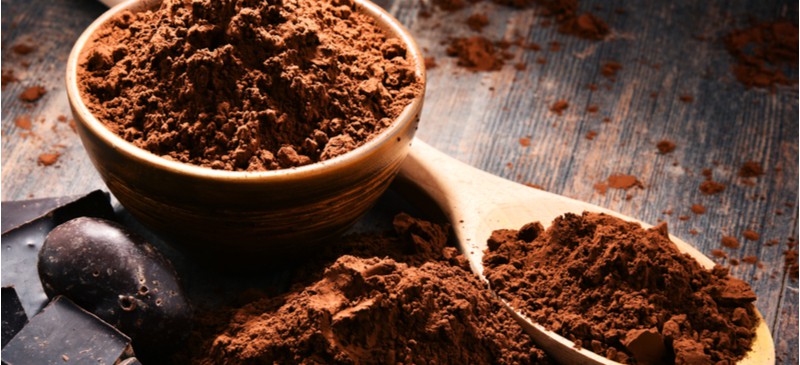
One of the main ingredients used to make chocolate, and the reason for its signature taste, is cocoa powder. While most types of commercial chocolates are high in sugar and calories and overall low in nutrients like antioxidants, good quality cocoa powder is still a rich source of many beneficial compounds.
Thousands of years ago, the Mayans considered chocolate (at the time, a cocoa drink prepared with cocoa beans and hot water) to be the “Food of the Gods.” Today we know that the key to getting the most from cocoa powder is using it in healthy recipes that are not overly high in added sugar, such as veggie and fruit smoothies, avocado mouse, and energy balls made with nuts and seeds.
When utilized in this way, cocoa not only provides a chocolatey taste, but can also contribute to a positive mood, lift in energy, and support for heart and metabolic health, thanks to its high supply of polyphenols, magnesium and more.
What Is Cocoa Powder?
Cocoa powder, also sometimes referred to as “cocoa solids,” is an unsweetened chocolate product made from removing cocoa butter from cacao beans. This process leaves behind a somewhat bitter-tasting powder that is rich in fiber, antioxidants and other nutrients.
Because the fat from cocoa beans is removed to make cocoa powder, it doesn’t have a creamy texture like regular chocolate does — however it still has a taste similar to dark chocolate, just not as sweet.
Cocoa beans grow on the tropical tree called Theobroma cacao. The seeds of the tree are the source of dark, natural chocolate in its many different forms.
Is cocoa powder healthier than chocolate? Cocoa and dark chocolate share many of the same benefits, including that they are high in flavanoids which help fight oxidative stress, as well as minerals like manganese and magnesium along with dietary fiber.
Types/Varieties
There are two main types of cocoa powder: dutch-processed and natural.
Here’s how these two varieties compare:
- The natural type (also called untreated cocoa) is more bitter and acidic. It’s processed in a way that retains its natural pH level, giving it a more intense flavor and a lighter color. Pure ground cocoa has a pH level between 5.3 and 5.8, meaning it has relatively high acidity. Its acidity affects its flavor, the way it interacts with other ingredients and how soluble/dissolvable it is. This type is also the highest in antioxidants.
- The Dutch type is made by soaking cocoa beans in an alkaline solution, producing a darker powder with a more mellow flavor due to how this affects the powder’s pH level. The processing method also makes it easier to dissolve the powder in recipes, such as in ice cream and chocolate drinks, but it reduces the antioxidant properties of cocoa.
What is the best cocoa powder? Because the natural type holds on to more of its valuable nutrients, this is the type you’ll want to choose if you’re interested in adding more antioxidants to your diet.
However, for baking purposes, sometimes the Dutch type is a better fit if you want a less intense flavor. Most recipes for baked goods, especially those that use baking powder, are intended to be made with Dutch-processed cocoa powder due.
Natural cocoa usually needs to be paired in recipes with baking soda, which neutralizes its acidity.
What is the difference between cacao and cocoa powder?
Cacao refers to cacao beans that have not been roasted, while cocoa is a processed chocolate product. In other words, cacoa is considered a mostly “raw” form of cocoa beans, which have been fermented and cracked but not heated to high temps.
You’ll find this type in both raw powder form and as cacao nibs, which are one of the best sources of polyphenols and have more antioxidant activity than tea, red wine, blueberries and even goji berries.
Cocoa (the roasted/processed kind) can be made into several products, including powder, butter and liquor. The powder is richer in antioxidants, fiber and minerals compared to both cocoa butter and chocolate liquor.
Chocolate is made from a combination of cocoa solids and cocoa butter along with sugar. The more cocoa and less sugar that is used, the darker the chocolate product.
Nutrition
Is cocoa powder healthy for you? Yes — and one of the main reasons why is because it’s very high in antioxidants, including several polyphenols — such as flavonoids and phenylethylamine.
Once most of the fat from cocoa beans is removed, the remaining powder is relatively high in carbohydrates, with about 58 percent of the mass being carbs. It contains about 14 percent fat, 20 percent protein and 3 percent water.
Cocoa beans are naturally high in several minerals, especially manganese, magnesium, phosphorus, potassium, iron and zinc. In addition to minerals, cocoa also contains some caffeine and theobromine.
One tablespoon of natural/unsweetened cocoa powder contains about:
- 12 calories
- 3 grams carbohydrates
- 1 gram protein
- 1 gram fat
- 2 grams fiber
- 0.2 milligrams manganese (10 percent DV)
- 0.2 milligrams copper (10 percent DV)
- 26.2 milligrams magnesium (7 percent DV)
- 38.5 milligrams phosphorus (4 percent DV)
- 0.7 milligrams iron (4 percent DV)
- 0.4 milligrams zinc (2 percent DV)
- 0.7 milligrams iron (4 percent DV)
Benefits
Below is more about cocoa powder nutrition benefits:
1. May Help Reduce Inflammation and Oxidative Stress
Cocoa is among the top sources of flavonoids and other antioxidants of all foods. Flavonoids have been found to have potent antioxidant and anti-inflammatory effects.
READ RELATED: Mini Cinnamon Crunch Banana Bread Is the Easy, Inflammation-Fighting Breakfast Recipe We’re Baking on Repeat
Cocoa polyphenols have also been shown to modulate intestinal microbiota, leading to the growth of bacteria in the gut that trigger anti-inflammatory pathways.
Many studies suggest that diets rich in these types of compounds can help decrease the risk for developing a number of chronic diseases, including certain types of cancer, heart disease, diabetes, neurological disorders and even obesity.
2. Supports Cardiovascular and Metabolic Health
A 2015 meta analysis found that adults who consumed higher amounts of chocolate benefited from a significantly lower risk of developing heart disease or dealing with a stroke or death. It’s thought this is true because cocoa’s antioxidants can help reduce “bad” LDL cholesterol and prevent blood blots due to their blood-thinning effects.
Flavonoids found in cocoa are also thought to improve circulation and nitric oxide levels in the blood, which enhances the function of your blood vessels. Additionally, there’s evidence that cocoa can help improve blood pressure, insulin sensitivity, blood sugar levels and reduce inflammation.
This offers protection against type 2 diabetes and metabolic syndrome, which are often associated with unhealthy diets high in processed foods and added sugar, as well as obesity. Cocoa also seems to help in weight loss by improving mitochondrial biogenesis, and it may increase muscle glucose uptake, which has benefits for your body composition.
3. Can Improve Your Mood and Energy
It’s not just in your head — cocoa/dark chocolate seems to have natural mood-boosting effects due to how its compounds affect the conversion of certain amino acids, such as tryptophan, into “feel good” neurotransmitters, like serotonin.
In studies, consumption of cocoa has been associated with mental health perks such as:
- reduced depression symptoms
- improved sense of well-being
- improved calmness and contentment
- reduced PMS symptoms
- potentially increase libido due to its supposed “aphrodisiac” effects
4. May Help Protect Your Brain and Improve Mental Performance
Studies that have focused on cocoa’s neuromodulatory and neuroprotective actions have found that flavonoids penetrate and accumulate in brain regions involved in learning and memory, especially the hippocampus.
The neurobiological actions of flavanols are thought to include protection of neuronal function and brain connectivity, improved blood-flow, and support for sensory systems. Animal and human studies suggest that cocoa consumption can promote normal aging of the brain and defend against dementia, stroke, cognitive decline, poor memory and mood disorders.
Polyphenols found in cocoa also seem to reduce the risk of neurodegenerative diseases like Alzheimer’s and Parkinson’s since they can help prevent oxidative stress from damaging neurons and important molecules in the brain.
How to Use (Recipes)
Cocoa powder adds a deep chocolate flavor to all types of recipes that it’s added to. These can include both sweet and savory recipes, such as baked goods and chili.
Here are some of the many recipes you can use cocoa powder in:
- Fudge
- Flourless chocolate cake and brownies
- Chocolate truffles
- Cookies, breads, muffins, etc.
- Desserts like mouses, puddings and ice cream
- Energy balls
- Smoothies
- Beverages like hot chocolate or espresso
- Mole sauces
- Chili
- Marinades for meat
When shopping for cocoa products, ideally opt for those that are Fair Trade Certified, organic and sustainably produced. This cuts down on the risk for consuming pesticides and other chemicals that can be added during the growing and manufacturing processes.
How much should you consume? To support general health, evidence suggests that it can be beneficial to include one ounce of high-flavanol cocoa powder or 0.5 to one ounce of dark chocolate in your diet regularly.
If consuming sweetened cocoa products, keep an eye on portion sizes, since these can be high-calorie foods.
Here are several healthy recipes to try using cocoa powder:
Can you substitute unsweetened natural cocoa powder for the Dutch type? These can be substitutes for another, however you’ll need to adjust the type of alkalizing ingredients you use with them to make sure that the taste and recipe come out right.
Sub natural powder for Dutch powder by adding about 1/8 teaspoon cream of tartar, white vinegar or lemon juice for every three tablespoons of natural cocoa powder, which helps adjust its pH and flavor a bit.
Store the powder in an airtight container in a cool, dark, dry place, but avoid putting it in the refrigerator or freezer, which will affect its texture.
Risks and Side Effects
Cocoa products naturally contain some caffeine and theobromine, which make up 1 percent to 2 percent of the cacao bean. Although these are not found in very high amounts in cocoa powder, compared to nibs or raw cacao, they are still stimulants that can have certain effects that some people may be sensitive to.
Caffeine/theobromine can dilate blood vessels and affect anxiety and sleep, so be careful about how much you consume if you’re typically sensitive to products containing these compounds.
Theobromine also makes cocoa and chocolate unsafe for dogs, so avoid giving these to pets even in small amounts.
Conclusion
- Cocoa powder vs. cacao powder, which is better? Cocoa, also sometimes referred to as “cocoa solids,” is an unsweetened chocolate powder made from removing cocoa butter from cacao beans. Cacoa, on the other hand, is raw, fermented and cracked cocoa beans and a bit higher in antioxidants.
- Cocoa powder nutrition benefits include providing polyphenols, flavonoids, fiber, manganese, magnesium and fiber. These can help support heart, metabolic and brain health and can have mood-lifting, energizing and anti-inflammatory effects.
- There are two main types of cocoa powder: natural and Dutch-processed. Natural is a better choice due to its higher nutrient content, however it’s also more acidic and a bit more bitter.
- When shopping or cocoa products, ideally opt for those that are Fair Trade Certified, organic and sustainably produced. Use the powder in smoothies, baked goods, energy balls, puddings, chili and hot beverages.
Source: Dr. Axe | Nutrition





